Mixing in key for better DJ sets
Harmionic mixing complete guide
There is one feature of modern DJ-ing hardware and software that stands head and shoulders above the rest, and thats key locking.
The ability to lock in the original key of a song and change its tempo to beat match other tracks has literally changed DJ-ing forever. Making Harmonic mixing possible.
So how do you master the DJ art of mixing in key? And what makes harmonic mixing such a creatively awesome DJ-ing technique?
This complete guide will walk you through every aspect of mixing in key, covering all the topics you need to know to up your DJ game and understand why key mixing creates better DJ sets.
So lets dive right in!

Lets start at the beginning and understand the fundamentals as this will help you master mixing in key. Its important to understand whats going on so you can make better judgements and perform better DJ mixes.
Every song is performed in a musical key. Notes that compliment each other are played on various instruments to create a sonically beautiful soundscape. Thats what every track does no matter what the musical genre.
There are many keys to choose from, although some are more popular than others in different music types as they create different moods and styles.
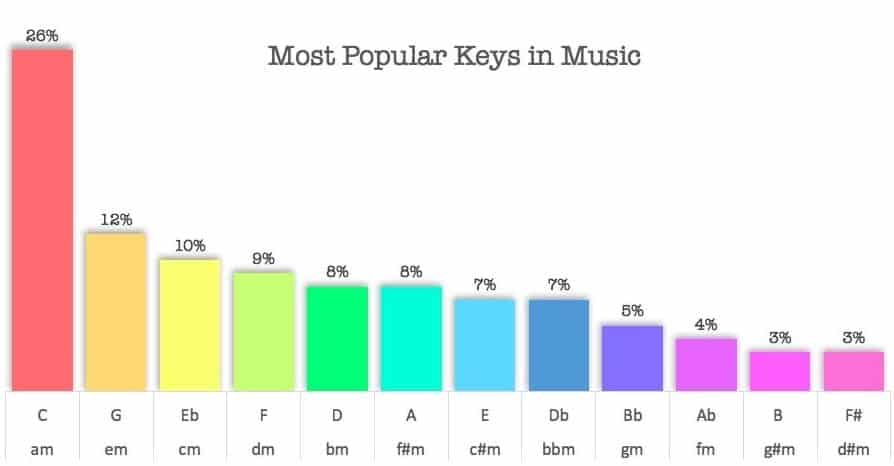
In order to understand why songs are in different keys and why some are more popular than others, lets take a quick look at all of the keys and the kinds of sounds they can create.
Here is a list of musical keys with descriptions of the emotional tones they convey. The # symbol means “sharp” while the “♭” signifies “flat”.
- C Major – Bright and happy. Pop music, uplifting dance music and children’s songs are often in this key
- C Minor – Heartbroken, unhappy because of love. Great for ballads and adding serious tones to dance music
- C# Minor – Passionately unhappy and depressed! Really piling on the anguish!
- D♭ Major – Tearful and languishing in pain. You wont find too much house music in this key
- D Major – Exciting! Often expressing winning or boldness. Brash and great for loud synths
- D Minor – Still bold but much more serious in tone, less winning, more battling
- D# Minor – Anxious and stressed. Often used for spooky sounds, think Halloween and ghostly tones
- E♭ Major – Vulnerability and love. Popular with songs about love as it sets a heart felt mood
- E Major – Tempestuous and energetic. Think passionate arguments and intense love affairs
- E Minor – Sings notes of loss and harm caused by or to others. Serious and heavy in tone
- F Major – Bombastic and angry at times. A key to convey the fury of life and mistakes made
- F Minor – The end of times filled with despair. It doesn’t get much more depressing than this
- F# Major – The battle between good and evil, with good always winning. Great for conveying triumph
- F# Minor – Quite the opposite of F# Major! Losing the battle with a passionate cry
- G Major – Fantastical and friendly. Filled with poetry and peace. Great for a sense of solidity and control
- G Minor – Unease and worry. Conveying life’s struggles
- A♭ Major – Infinite Judgement. Often used to convey serious religious subjects and deep social wrongdoings
- A♭ Minor – Negative and struggling. While not a depressing tone it does set the stage for severity and dominance
- A Major – Screaming passions of love from the rooftops! Young and care-free. Bright and breezy!
- A Minor – Gentle and elegant. A soothing experience unlikely to surprise
- B♭ Major – Happy and cheerful. Great for songs of summer and a brighter tomorrow
- B♭ Minor – The complete opposite! Giving up on life, tones of darkness and pessimism
- B Major – Strong, deep and powerful. Great for conveying the rumbling thunder of an approaching storm
- B Minor – Calm and controlled, the passage of time never ending. Holding back, meditating
So you can see there’s quite a range of emotions, human struggles and situations covered just by picking a particular musical key. There are many reasons different musical keys are used and this has been studied at length for over a hundred years.
While its entirely possible to produce very different music from the descriptions you see above, its generally considered that certain keys are now linked to certain genres of music. So take the list above with a pinch of salt but understand its now somewhat engrained in the culture of western music. D# Minor for example is now forever linked with horror movie sound tracks, conversely its no surprise most pop songs are in the bright and happy C Major.
There’s a few things to note with this list above
Some of the keys are not fun to listen to! D# Minor for example is a complex key creating an often painful and un-entertaining sound. The chances of you ever hearing a full song in this key is very rare! Although you may hear it in horror movies or theatrical performances for short bursts of emotional sounds.
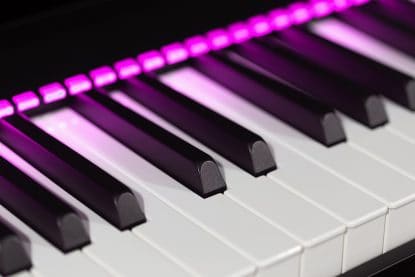 The most popular keys depends on the music genre but generally for dance music the minor keys are used slightly more often than the major keys. A recent analysis showed the most popular keys for house music to be:-
The most popular keys depends on the music genre but generally for dance music the minor keys are used slightly more often than the major keys. A recent analysis showed the most popular keys for house music to be:-
- A Minor – Gentle and Elegant tones
- C Minor – Heartbroken love with serious tones
- F Major – Battling and winning
- B Minor – Strong and deep
- D Minor – Bold and serious
You see a pattern emerging there? Of course there’s plenty of examples of other keys being used but the elegant, loving, serious, battling, strong and bold themes are often what musicians want to convey.
So how does knowing the key of your songs help you be a better DJ?
Once upon a time all DJs had were two turntables and some vinyl records, we beat matched the tracks together, speeding them up or slowing them down until the beats were in phase, but this changed the key of the tracks and chances are they’d never match each other.
This was the norm. But now with digital DJ-ing setups we can lock the key and change the pitch to beat match. So now we can find songs in the same key and mix them together. Or songs in complimenting keys and build a sonically compelling journey through the keys, changing your audiences emotional attachment to the music.
How awesome does that sound!? Here’s an example of why its so awesome.
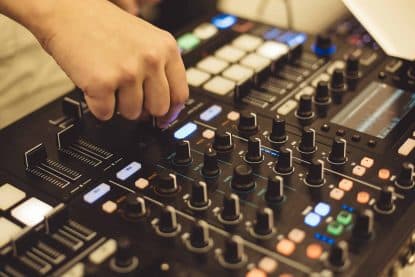 You start your DJ set playing a tune in B Minor. Giving gravitas and a strong bold tone to the start of your show. You may extend that feeling with 1 or 2 more tracks also in B Minor.
You start your DJ set playing a tune in B Minor. Giving gravitas and a strong bold tone to the start of your show. You may extend that feeling with 1 or 2 more tracks also in B Minor.
Then you kick things up a notch with your next track in D Major. Intensity is added to the set! Loud brash sounds that add passion and energy.
Extending and solidifying that warm feeling of success, you switch to the next complimenting key of G Major with it friendly tones of fantasy and illusion. Taking your audience on a journey through sound.
Then you decide to shock them by switching to the more emotional state of E Minor, a key with a yearning loss of love.
Ending your set back with tracks in A Minor. That soothing emotionally connected key that many people will recognise.
Quite the journey huh?!
All of this is possible with mixing in key as some keys compliment each other and can be transitioned between while still sounding audibly seamless. You can build emotions throughout your set, taking the crowd on a journey and creating near seamless mixes where the sounds work together rather than battle each other for dominance.
Sounds amazing right? Why wouldn’t you want to DJ like this!
There is of course a number of steps you’ll need to take to make all of this possible. Don’t worry we’ve got you covered.
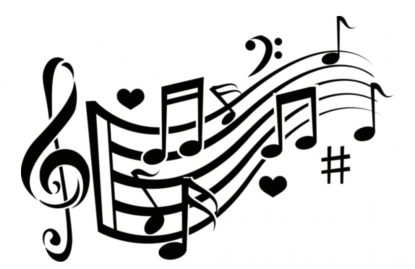 Unless you’re a musician as well as a DJ its unlikely you’ll know exactly what keys compliment each other.
Unless you’re a musician as well as a DJ its unlikely you’ll know exactly what keys compliment each other.
Thankfully there’s a neat solution to this, although it can differ depending on the DJ software you use.
Imagine a circle or clock split in to 12 sections. Each of those sections is split in to 2.
With Minor keys on the inside and Major keys on the outside. This gives you a “wheel” of 24 segments, or 24 keys to choose from. The segments are then assigned keys, with those in adjacent segments being complimentary to their neighbours.
Camelot System
This wheel is known as the “Camelot System” and was invented by Mark Davis. Its a colour coded visual representation of keys and their complimentary neighbours. It draws inspiration from the “Circle of Fifths” that some musicians may be familiar with and was originally called the “Easy Mix System” when Mark first created it in the mid 80’s.
Rather than keeping the slightly confusing names of of D-flat Minor and F-Sharp Major the wheel is like a clock, split in to 12 segments. With numbers 1 to 12. The inner ring is suffixed with an A and the outer ring with B. So 1B will mix harmonically with 2B and 12B. Just as 6A will mix harmonically with 7A and 5A.
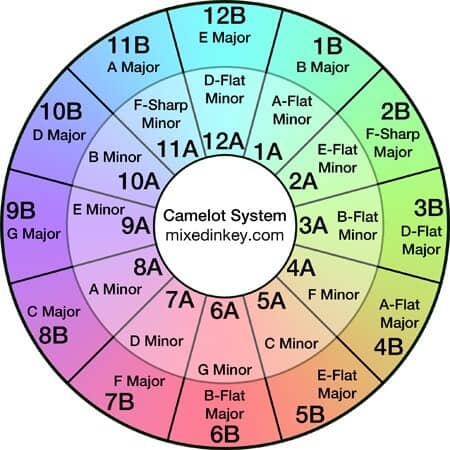
Not only that but you can jump between minor and major keys as long as they are the same number. So 6A will compliment 6B.
Up until fairly recently this Camelot wheel was the best method of visually mixing in key and finding complimenting neighbouring keys. That is until Open Key came along.
Open Key
This key wheel builds upon Mark’s Camelot Wheel, with a few changes to make it more visually logical for musicians. It’s a little harder to understand for DJs as the correlation between the Camelot Wheel and this wheel are lost a little.
It’s important to know that Open Key exists as your DJ software may mention use of this as an option. Its more related to the circle of fifths that I mentioned earlier so musicians will often use this key wheel.
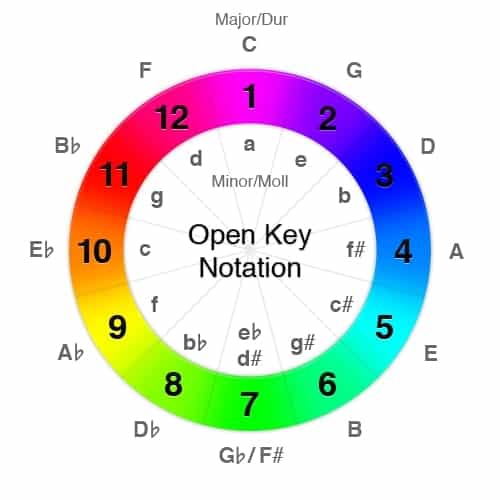
Open Key doesn’t use A and B to label its inner and outer wheels, instead opting for Minor on the inside (Or Moll in German) and Major on the outside (Dur).
Generally speaking I don’t recommend it for DJs and you’re much more likely to see the Camelot System in use. Although some DJ software does support switching to Open Key. If you’re already a musician then this may suit you, for everyone else, maybe not.
Traktor’s Open Key / Camelot wheel hybrid
If you’re using Traktor DJ software from Native Instruments you’ll notice you don’t see “1A” or “6B” in the key column of your music library. Instead Traktor attempts to merge both approaches above in to their own key wheel system.
The reason for this is that the original “Circle of Fifths” that has been in use for hundreds of years starts with C Major and A Minor at position 1 at the top, while the Camelot wheel has that down in 8A and 8B. Confusing right!?
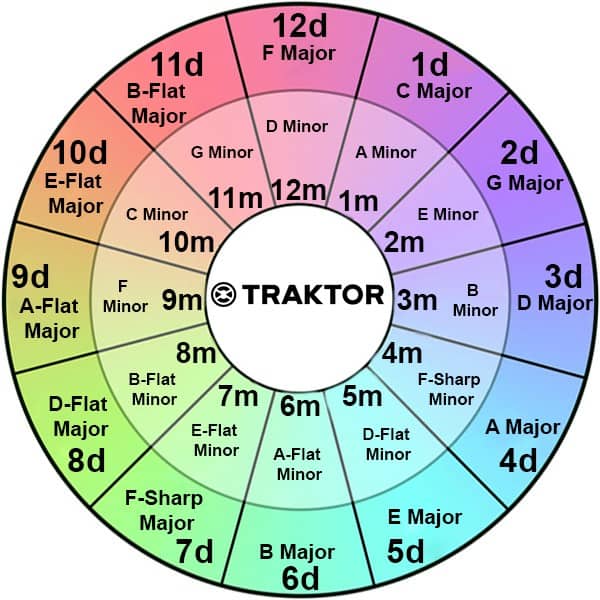
Traktor’s wheel rightly has C Major at the top like the circle of fifths and and labels this as 1d. The “d” representing “Dur”, the German for Major. and 1m being the inner segment of A Minor.
While this may seem confusing at first it soon makes more sense and is used in exactly the same way as the Camelot Wheel. Neighbouring segments compliment each other as well as those with the same number.
The important thing is to understand what you’re seeing when your DJ software shows you the key of songs. Whether its displaying 6A or 6B… or maybe 4d and 4m. Understand these wheels and what they represent.
They will help you plot your journey through keys to create the best set possible.
Of course to be able to mix in key you first need to know the keys of the songs in your music library.
Things have moved on immensely in this department in recent years and there’s a number of tools you can use to find the key information you need to make harmonic mixing possible.
Its important to point out that you must have this key information stored in your DJ software and have the ability to lock keys in your software too.
Most pro quality software like Traktor, Serato and Rekordbox can handle this, if you’re using something else please check first and consider switching if its not possible.
Traktor
If you’re using Native Instrument DJ hardware and the Traktor Pro DJ software like me its pretty straightforward. When you import new tracks in to the Traktor music library it’ll ask if you want to analyse them for multiple items. This includes its tempo (BPM), its volume level so all tracks have the same volume and also its key.
If you’re doing this before you DJ then I recommend using the option to analyse multiple tracks at once to speed up the process.
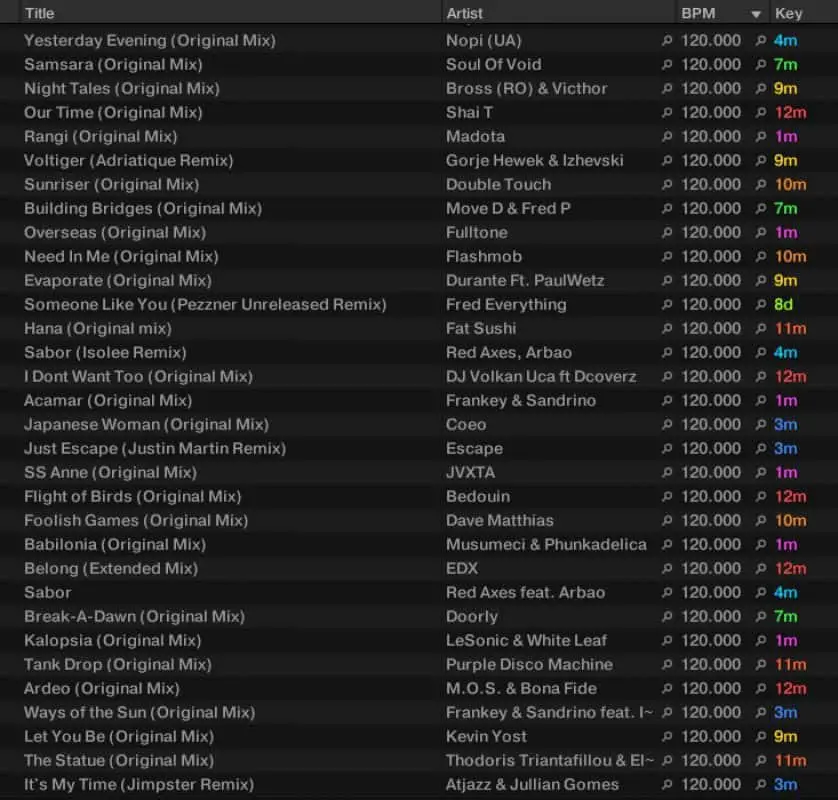
You can also right click on any track or collection of tracks and select the “Analyse” option to start the same process. Once done the information about the musical key your songs are in is stored and displayed in your music library.
From there you can sort your library by key and also see highlighted and colour coded keys for those that compliment your chosen track.
Serato
Serato has a very similar system for analysing tracks. You’ll see the big blue button labelled “Analyse” when viewing your music libraries folders and files. You can drag an entire folder to the analyse button or you just a single track.
Serato will get to work analysing much the same items that Traktor does including the song’s key. It’ll handle multiple tracks at the same time too.
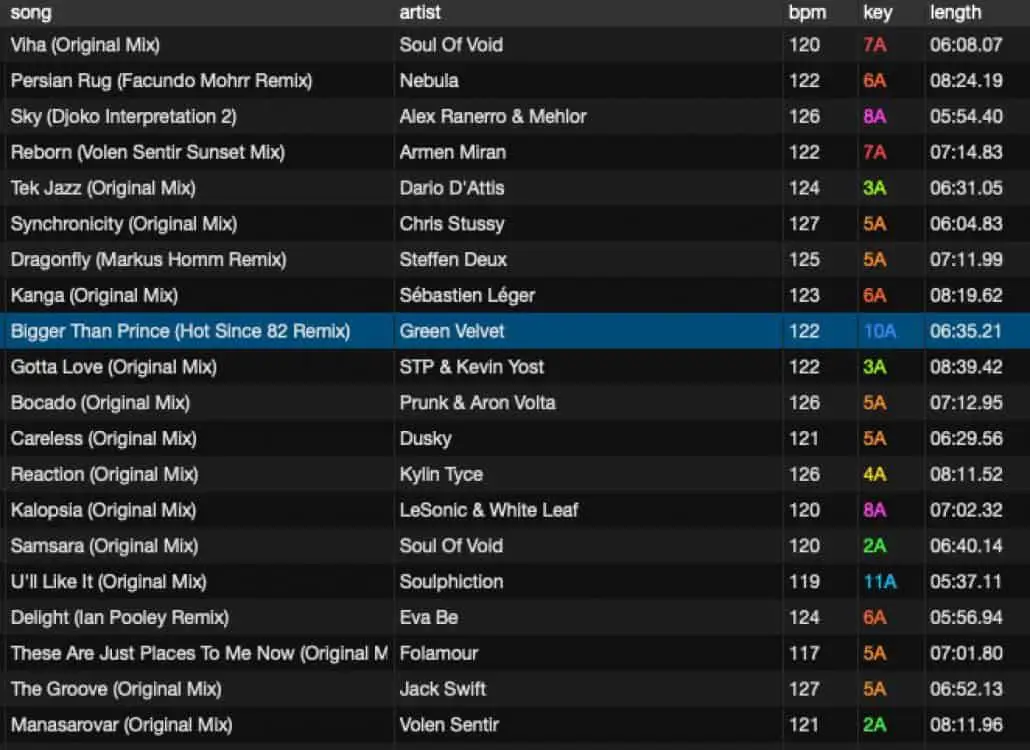
Serato have actually taken it a step further with integration from industry leading key analysis software “Mixed In Key”. More on them later. The important thing is there’s plenty of options to not only analyse the key of each track but also create new playlists and smart lists.
Rekordbox
Pioneer’s industry standard software can of course analyse keys of songs too. They offer two modes of display for this and your software may be set to “Classic” model which displays the original names of each Key like F#m or Gm. This can be a bit confusing as its not telling us adjacent numbers.
I recommend you switch this to the more intuitive “Alphanumeric” mode in your preferences which will then display the Camelot numbers of 8B, 1A, 6A, etc.
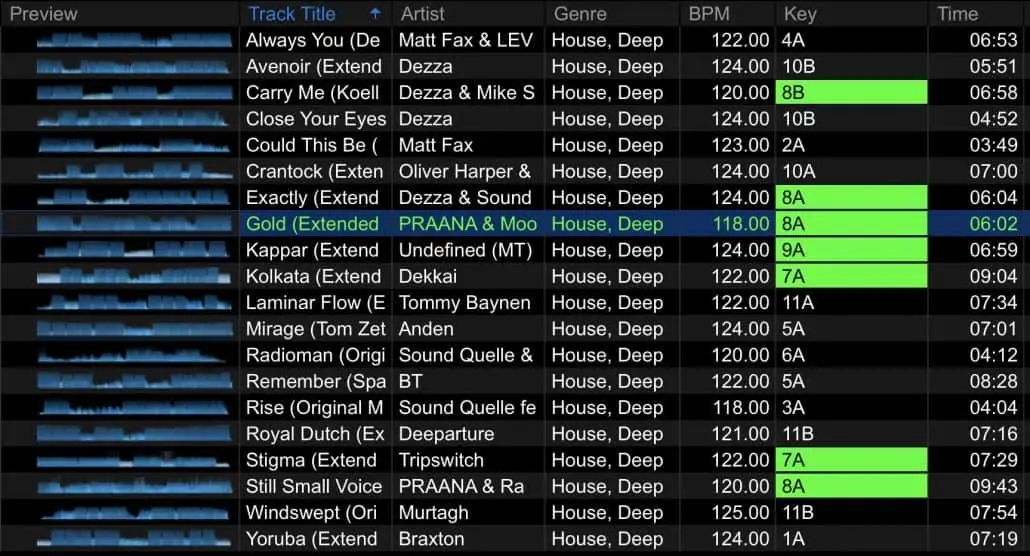
Once you’re playing tracks Rekordbox has what they call a traffic light system to display tracks in the same or complimenting keys. Its a bit of an odd name as it actually only highlights in Green, not amber or red. But its still a handy feature to quickly see what tracks may compliment your master track.
Mixed In Key
While its role in key analysis has been somewhat superseded by DJ software integrating their own solutions, Mixed In Key is a standalone app that many DJs use for a more detailed analysis of their music libraries.
Over the years they’ve added more handy features to this software to keep it relevant and something to consider over simply using built in solutions.
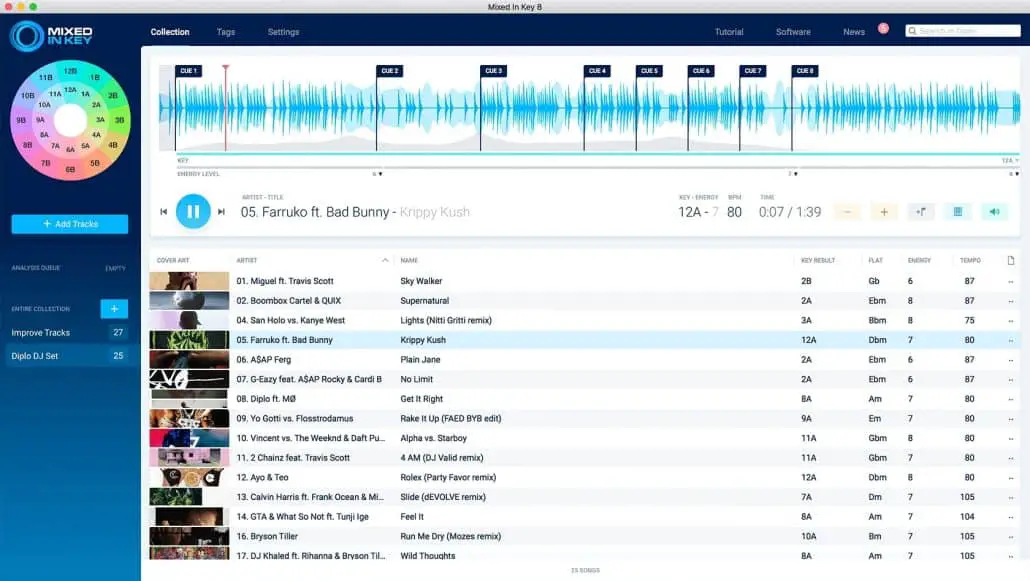
The Mixed In Key app runs on both Windows and Macs and allows you to not only analyse large music libraries quickly, it also lets you build playlists built on key and other factors it can analyse. Recently they added “Energy” scores to each track so you can build a set based around these metrics. Increasing the energy level of your set as you go.
Its worth looking at if you want to get more out of your track analysis. The likes of David Guetta, Diplo and Pete Tong use Mixed In Key so they must be doing something right.
A note on Key detection accuracy
Software can only go so far in detecting the key of songs and while they all do a pretty good job they are never perfect. So while its very easy to just press a button and let your DJ software do its thing, remember it may not be giving you the right information about your tracks.
Keep this in mind when you’re mixing your songs. I highly recommend you build a playlist and test your tracks with each other before playing them out to a crowd. It may well be that the software did a bad job of analysing the track and isn’t the key it says it is.
If you can find out from the producer of the track exactly what key it is you’ll have a much better chance of mixing in key. This also means you don’t need to waste time analysing tracks for key.
As ever don’t fully rely on computers to do everything for you. They have a tendency to make mistakes!
Most of the pros used Mixed In Key in order to get the most accurate key data for their music collections. Deemed by many as the industry standard for harmonic mixing, still its always best to be careful and make sure the tracks your mixing work harmonically together.
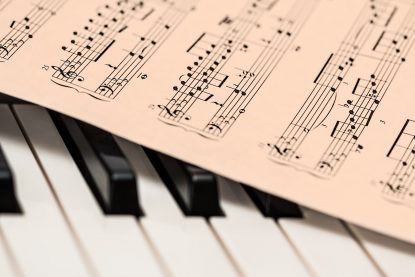 So now you know what musical keys are, how they can compliment each other and how your DJ software can analyse your music and display key data.
So now you know what musical keys are, how they can compliment each other and how your DJ software can analyse your music and display key data.
Its time to put all of that to good use and actually build a DJ set list.
You music library is no doubt full of tracks you could choose from and while you could just sort by key and drag and drop them in to a new playlist, its going to give you songs you probably didn’t want and all in the same key too. So unless that was your intention its not going to give you the best results.
There’s a couple of approaches to building set-lists for mixing by key.
Mapping your key journey
Using the key wheel along with the descriptions of keys I gave in chapter one, you can put together a harmonic journey through sound.
Lets say your set is 60 minutes long, roughly 15 – 20 tracks.
In this time you’ll be able to take your audience on a journey through multiple keys. At least 2 songs per key. So at most 10 keys. This is quite a lot so lets say 3 songs per key, giving you 6 keys to travel through during your set.
You’ll want a good starting and end point for your set so I recommend plotting what your starting and ending keys will be. Its often wise to start with some flair and boldness, and end with a similar style of key or one that will conclude the emotional journey perfectly.
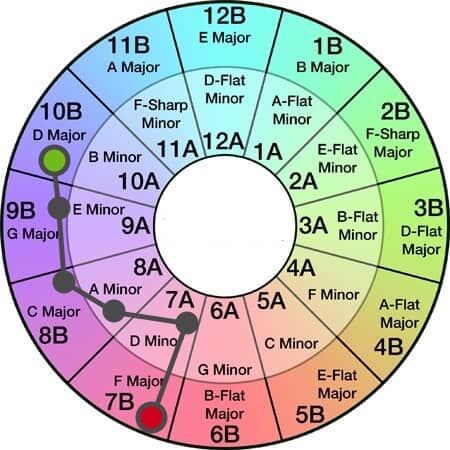 Here is a very typical 6 key transition that would work well for a club audience due to its bright and bold nature. I’ve used the Camelot Wheel for this so you can see the journey from start (green) to finish (red).
Here is a very typical 6 key transition that would work well for a club audience due to its bright and bold nature. I’ve used the Camelot Wheel for this so you can see the journey from start (green) to finish (red).
- D Major (10B) – A big bold start, exciting and powerful
- G Major (9B) – Building on the exciting start with more melodic and fantasy like notes.
- C Major (8B) – Increasing the energy with bright and happy sounds
- A Minor (8A) – Pulling back a little with more elegant and emotional tones
- D Minor (7A) – Building up the power while also switching from positive to a more serious darker tone
- F Major (7B) – Finishing with a bold and celebratory key
You can see from the keys used, their emotional impact on their listeners and the way they compliment each other on the key wheel, this could be quite the combination.
A clear path from one sonic tone to another, taking your audience on a journey.
I recommend having at least 2 songs in each key but for this 60 minute example I’d recommend 3 per key. You could have 4 in one key and 2 in another.
Finding the tracks to fill the 6 keys
Your task now is to trawl through your music collection to find songs in those keys. I recommend you look at a specific genre first to narrow down the selection and then sort by year. I often find I’m looking for recent tunes so there’s no point searching by key if my library contains tracks from 5 years ago. Then its a quick repeatable 3 step process…
- Look for tracks that match your criteria including one of the keys above
- Drag and drop them in to a new playlist
- Build up the playlist until you have at least 5 songs per key
You should now have at least 30 songs in your playlist, clearly more than you need which is important. You need reduce the set down to 17-20 tracks in order to mix for 60 minutes.
Sort your playlist by key, In our particular set we want to start highest number first since we travel down the numbers from 10 to 7.
I recommend you listen to each of the tracks to figure out which order they would be best suited in. From this you’ll be able to tell which of the 5 or so tracks you have should be kept and what order they work best in.
Its a lengthy process but you will eventually end up with 3 or 4 awesome tracks of the same key, travelling through our 6 chosen keys, with a clear start and end point.
I’ll have more tips and tricks on key mixing later in the article. But first the other method which takes a little less time.
Create a Key path based on preferred tracks
Another method that usually takes less time is to start with the tracks you know you’d prefer to play, then filling in the key gaps to create a path. This takes much less time because you’re not too worried about what key tracks are in when you pick them. And since you probably already have an idea in your head of what tracks you want, it’ll be quicker to select them.
So how does this method work?
Add songs you know you want to play
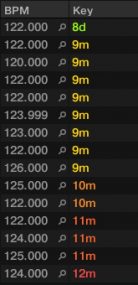
Firstly create a playlist and drag and drop in any songs you know you would definitely like to play. I recommend adding in more tracks here than you actually need in order to be able to remove some later that don’t compliment the keys of other songs.
If its an hour set you might want 15 or so tracks, so be sure to add around 30, maybe 40 to be safe.
Go to your playlist and sort it by key
Jump right in to your playlist and click on the “key” column. This will sort your tracks by key. Because they are alphanumeric you’ll see the keys in an order that are most likely to compliment each other.
What you will probably see is clusters of tracks in specific keys, with some keys have more than others. From this you can work out which keys to stick with and which are on the upper and lower limits that you just wont be able to reach in a 60 minute set. Remember we’re looking for around 6 keys maximum.
From the 40 or so tracks you have you’ll see a range of keys that are next to each other. These will be the easiest to work with since most of your playlist is in that range. Remove the tracks outside of this range and see what you have left. You may have around 25 tracks or so that you can now mould in to the perfect set list.
You have a few choices now. Look at the keys of the tracks and work out a path up and down the keys. Remember you don’t have to just travel up, you could travel up 2 or 3 numbers before changing from major to minor and coming back down. Or you can keep it simple and just travel up the numbers.
Switch the sorting off, usually by clicking on the track number column which will then allow you to drag and drop the tracks in to the order that sounds best to you.
This method of playlist building will create a very different path to those you might create with the first method, but its much quicker and can still produce amazing results.
Here’s an example of a recent mix for The Top Show, our exclusive weekly show on Mixcloud. Created with this method.
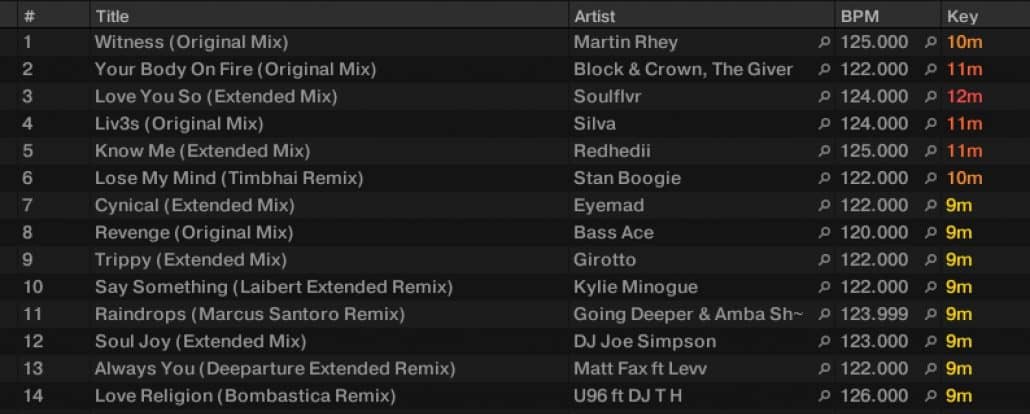
This mix was created in Traktor so uses their numbering system for keys.
See how it started in C Minor before moving on to G Minor, onwards to D Minor before heading back down to G and C Minor, then a large section of powerful, Serious tracks in F Minor.
This mix went straight in with a serious tone, good for dance music, building on that serious start and ramping it up, setting the mood nicely. We kick things up a notch with an increasingly bold and serious vibe, with elements of emotional struggle. Then levelling out with the super emotional F Minor to really tug at the heart strings once we’ve got the crowd on board with the musical feeling we’re trying to create.
You can of course just pick a key and find tracks in it that work well together. This would be the quickest method and can work just as well as those mentioned above. Its definitely easier if you have a large music library and can find enough tracks in the same key.
The biggest difference is that you’re relying on the energy of the tracks to influence the crowd response, rather than having that extra tool in the box to change the mood with keys.
Some may argue that sticking to one key for an entire set could make the playlist sound boring and uneventful. Well we can prove that wrong right here right now!
Mixing an entire set in one key allows you a creative freedom to loop, sample and transition at almost any point during any of the tracks. You can seamlessly mix for minutes at a time, adding extra loops and moments from each track on top of each other to layer with confidence that every track will compliment the others.
It also creates what I would call a “mood set” where there’s a given tone to the entire set. Its just as creative as changing moods with keys.
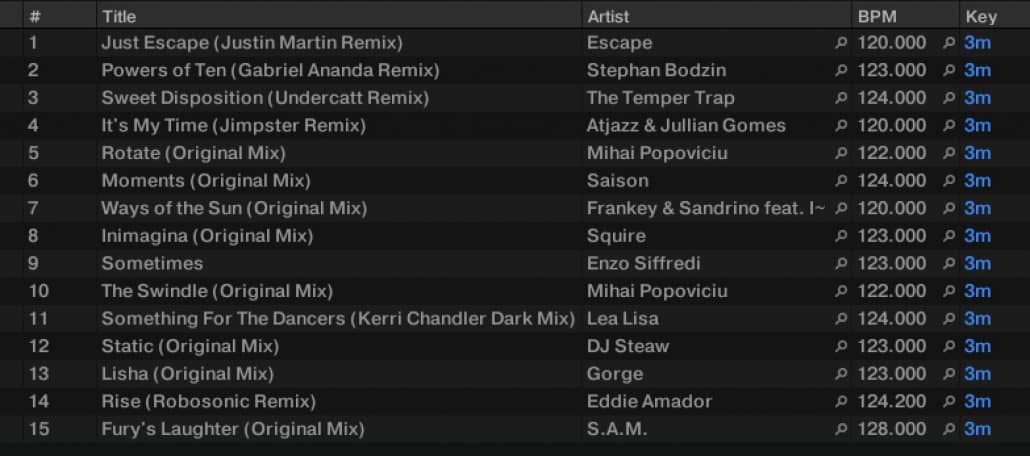
Key mixing in this way creates an entirely new creative freedom that quite literally needs to be heard to be believed. So we created a mix just for you to hear this.
Check out this recent set for The Top Show that was all mixed with tracks in the key of B Minor (3m on traktor and 10A on the Camelot wheel). This key is great for deep house as its dark and moody, somewhat somber and serious but still with a beautiful feel to it. You’ll find plenty of deep house tracks in B Minor!
You’ll notice that this set seems to drift from one song to another in a seamless fashion. That’s because I was able to mix two tracks for a much longer period of time, slowly increasing volumes of frequencies individually and adding affects that help keep sounds in the background until they can take over from the outgoing track.
If you want to know more about advanced mixing techniques like the seamless mix then check out our detailed tutorial on the subject.
If you’ve created a playlist with multiple keys, congratulations! Its going to sound amazing. Now we just need a few tips on the best methods of mixing to make the most of the journey between keys.
Remember the point of harmonic mixing with multiple keys is to intensify or change the mood of your set, so your transitions can be creative and really add to this audio experience for your crowd.
Starting the set
I recommend you play the first 2 or 3 tracks in the same key. This will establish your set with an opening “mood” getting your crowd on board and giving you space to breath as you’ll know with confidence your first 3 tracks will mix well for long transitions.
Essentially you’re blurring these tracks in to one long amazing sound.
Once the crowd are feeling the amazing vibe you’re giving them its time to take them with you on the next part of your journey!
Switching keys is great because it not only clearly makes a audible difference your crowd will notice, but it gives you a chance to be bold and daring with your mixes.
You don’t have to do seamless mixes here. In fact you could argue its the perfect opportunity to do the opposite.
Try looping a part of the incoming track and playing it over your primary track. Teasing your crowd with whats coming next while still remaining complimentary in key.
Then when its time to drop the hammer you can unleash the new bass-line, either by jumping to a different hot cue or by dialling in the new bass-line with frequency controls, dropping out the old bass-line quickly.
This approach establishes the new key as dominant, taking full control of the set and pointing the way to your crowd.
Key changing can build energy or take the crowd on a surprise turn. So let your mixing transitions do the same!
You’ll have the crowd eager for more, and you’ve now got 2 or more tracks in that key to start looping and seamlessly mixing on the next part of the journey.
Quick transitional dominance when building energy
Quick mixes that show the crowd the new track is the boss work really well when you’re picking up the energy levels.

In our earlier idea for a key journey we moved from D Major (10B) with is big bold start, moving on to G Major (9B) Adding a fantastical melodic note to the proceedings, before increasing even more with C Major (8B) peaking at that super happy vibe.
When you’re working your way up the energy levels like this you can punch in the next mix with creative flair as it helps show the crowd you mean business! So be prepared to quickly switch and blend.
Long transitions when switching to darker moods
So you can see how punchy bold mix transitions can compliment a change in increased energy through key changes. The opposite can be said for switching from those brighter keys down to more dark and moody keys.

Think of it like weather. Bright sunshine slowly being covered by dark thunderous stormy clouds bringing a serious and dark vibe to your set.
Sounds pretty ominous right? Something people will take note of and get on board with.
For this key shift I recommend longer transitions where the darker more moody sounds build, slowly removing the bass from the previous key and bringing in with the new. Fading the sounds from one to the other creates a feeling of suspense, even anxiety. At least in an musically emotional way.
Try mixing a song in A Minor (8A) to one in D Minor (7A) with a long seamless mix. You can even use affects like filters or reverbs over non-percussive loops to add to the ominous change in direction your set is taking.
These long sweeping mixes work well for this key change type. Give it a try!
No hard and fast rules. Be creative!
Of course these mixing styles are not the only way to transition between keys. It really depends on the contents of the tracks, whether they have vocals, what their bass-line patterns are like and just how energetic the music producer made the tracks.
Its all about experimenting during jam sessions to find out what works and what doesn’t. After years of practice this becomes second nature. You become one with the music and your DJ gear. The mark of a true professional DJ!
All of the advice in the previous chapters is good solid groundwork for mixing with keys but there’s a lot more to harmonic mixing than meets the ears!
You’ll find that for some tracks the mixing styles, the desired key changes and the method of building playlists just doesn’t work.
There’s good reasons for that too, which the following tips can help you identify and remedy!
Not all tracks will work together
 Its true even though your DJ software and the wonderful Key Wheels tell you they are complimenting keys or even the same key, some tracks just wont sound good when mixed harmonically.
Its true even though your DJ software and the wonderful Key Wheels tell you they are complimenting keys or even the same key, some tracks just wont sound good when mixed harmonically.
Sometimes its the arrangement of their notes, other times its their use of instruments or the timing of their melodies that just doesn’t work.
This is why its wise to always build playlists with plenty of track options so you can weed out the tracks that just wont fit. You’re looking for a harmonically seamless audio experience after all, so there’s no point crow-barring in a track that is going to cause you issues.
In fact when DJ-ing with keys having that one track thrown in the mix that just doesn’t harmonically fit will stand out even more as all the other tracks you’ve played have gelled perfectly.
Be ruthless in your track selection. Its worth it for perfect key mixes.
Some tracks work better than others to start and end a set
You may want your opening track to start without beats, with an etherial sweeping vibe that climaxes with a big sound. Not all tracks in your chosen starting key are going to do that. So you’ll need to find one that fits this purpose.
You don’t always have to start a track from the absolute beginning.
Similarly to close the set in just the right way there may be a track best suited to this role. Maybe in the way it ends, or how well it fits the “celebratory” tone we’re going for here. Pick the start and end tracks first.
The journey isn’t just about keys
 Putting together a DJ set list isn’t just about creating a key set you can travel through or playing songs in the same key.
Putting together a DJ set list isn’t just about creating a key set you can travel through or playing songs in the same key.
The energy levels of each track, choice of sounds to convey emotions and even then subject matter of the vocals can all influence a crowd in ways that can potentially be contrary to the vibe you were going for.
Moreover the percussion patterns and strength of some of the sounds may not play well with another song. So key complimenting or key matching isn’t the be all and end all of creating the perfect set list. It takes knowledge of your music library and each track to help create the best DJ set which we’ve written an article on here.
The sync button is your friend
There’s always a raging debate about whether or not using the automatic “sync” mode on your DJ controller is effectively cheating at DJ-ing. We’ve answered this quite comprehensively in our article on learning to beat match. But whatever side of the fence you sit on I highly recommend using sync mode when DJ-ing with keys.

This is because the creativity and focus is on other aspects of DJ-ing. When you have two tracks in complimenting keys you can loop, sample, mix for longer periods, add layers from multiple tracks, even 4 deck mix if you want. All of which takes mental resources. So take beat-matching out of the pile of tasks and get creative!
Also when you’re DJ-ing with keys you want the seamless sound of 2 (or more) tracks playing in perfect unison to be the creative flair, so any deviation in synchronisation will stand out and shatter that blended illusion you’re trying to perfect.
You don’t always have to harmonic mix
This may seem like an odd point to make on a tutorial about mixing in key but its true. Not every song in your set list has to mix perfectly harmonically with those around it. If you really want to include a track but it doesn’t fit with any of the keys, or the timing you want to play the song, don’t be afraid to break from mixing in key.
Its all about when you mix and how you mix in the next track. The easiest is looping percussion endings with percussion beginnings where there’s less sound clash. Don’t be afraid to get creative and let that new bold, different track dominate with its new non-harmonic key and take over the party!
While harmonic mixing in key can create beautiful soundscapes, breaking out of it can do the same sometimes. Be creative.
A note on audio degradation
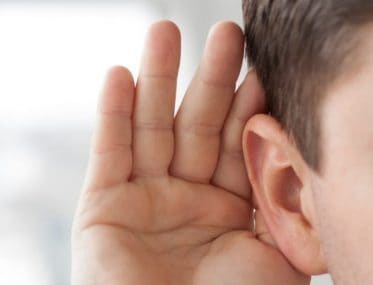 Playing a track at its original speed will always sounds superior as your DJ hardware and software are manipulating the data to produce a new tempo while locking the key.
Playing a track at its original speed will always sounds superior as your DJ hardware and software are manipulating the data to produce a new tempo while locking the key.
Whether that audio quality loss is noticeable is another matter. Its something DJ software makers have been trying to perfect, and with each new version of DJ software and Hardware they are improving the playback quality to near perfect levels.
I would argue the acoustics of a venue will degrade audio quality more and the noise your audience is making while you play out are likely to mask any possible audio degradation caused by locking keys with DJ software. You may of course have a different opinion.
More useful DJ tips for you
So now you know how to DJ mix in key. Here’s some more tutorials that will help improve your DJ sets.
